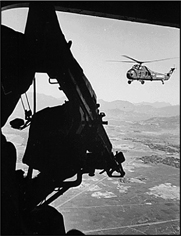
The Vietnam War was the first to make widespread use of helicopters. These aerial, mechanical “horses” gave these twentieth-century cavalry troops mobility and battlefield firepower support that had never been seen before. A whole military doctrine was created for this new style of fighting called “airmobile operations.”

Helicopters on a mission in Vietnam.
Though planes were a part of airmobile operations, helicopters were the primary aircraft used. Helicopters could rapidly carry troops to isolated areas and land in clearings too small or rugged for airplanes. They could also provide close, hovering, treetop-level fire support against enemy positions, and quick evacuation of the wounded. The U.S. forces employed twenty types of helicopters in the Vietnam War. The workhorse of the group was the Bell UH-1H Iroquois, more popularly known as the Huey, which could be easily adapted to the roles needed. As troop transports, known as “slicks,” the Huey carried troops and supplies. Gunships, known as “cobras,” had extra machine guns and cannon. “Medivacs” were designed to quickly transport wounded from the battlefield. Command ships had extra communications equipment and were used by commanders flying over a battlefield.
Airmobile operations freed troops from being tied to road networks or waterways that could be cut off by the enemy. Even if an American unit was surrounded and was fighting a superior enemy force, it was not totally isolated. Because of the unique mobility of helicopters, they could swoop in at a moment’s notice and provide additional firepower or troop reinforcements. U.S. Army General William DuPuy explained, “[F]rom the first shot [fired] and every minute thereafter the advantage turned in our favor because the Viet Cong or the NVA were seldom able to reinforce . . . But every minute we were able to bring in fighters, attack helicopters, artillery, and additional troops by helicopter.”
Helicopters were the primary air arms of the army and marines, but not of the air force. Air Force Captain Bruce Wallace witnessed the use of gunships against the enemy. He said, “It is always an experience for an air force pilot to watch a gaggle of Hueys attack a target. . . . In [an air force jet squadron] attack, the target is always in front of us. Not so with a Huey. To watch four or eight of them at a time maneuvering up and down and laterally and even backward boggles a fighter pilot’s mind. Those guys swarm a target like bees over honey.”